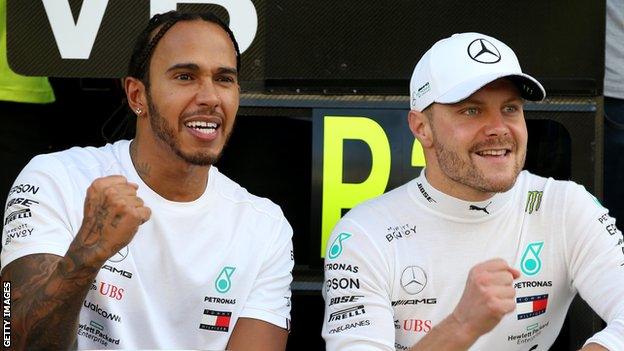Jolyon Palmer column: Ferrari overcomplicating life with team orders
- Published

Former F1 driver Jolyon Palmer, who left Renault during the 2017 season, is part of the BBC team and offers insight and analysis from the point of view of the competitors.
"Deliciously ironic" was how Mercedes technical director James Allison described Lewis Hamilton's victory in the Russian Grand Prix, after the race fell apart for Ferrari.
And the irony falls in two ways.
Sebastian Vettel disobeyed direct team orders to put himself in with a chance of winning the race - before Ferrari intervened at the pit stops - and then retired.
And after Ferrari did everything they could to orchestrate a one-two finish by imposing those teams orders in the first place, Vettel's retirement cost them the race.
The grand prix itself was not the greatest in terms of action and excitement, but it raised a number of questions about Ferrari and how they handle their drivers in the future.
Ferrari guilty of overthinking
Ferrari went into the race in Sochi with a plan that they thought was the best way to guarantee a second one-two within a week, after Vettel led home team-mate Charles Leclerc in Singapore, but it was unnecessarily complicated, and fell down as a result of Vettel taking things into his own hands.
With Leclerc on pole and Vettel in third - and Lewis Hamilton's Mercedes in between - Ferrari came up with an idea to ensure both their cars led around the opening lap.
They used Leclerc to give a slipstream to Vettel on the long run down to Turn Two, the first proper corner, in a bid to get the German past Hamilton.
The idea was that Leclerc would not defend against Vettel into the corner, to give him the absolute best chance of passing Hamilton, and then Vettel would hand the lead back to Leclerc.
It worked - but immediately led to problems, when Vettel refused to give back the lead. You have to question why Ferrari needed to make things so complicated.
In reality, passing Hamilton at the start was never likely to be hard for Vettel, whose Ferrari had softer, grippier tyres, the cleaner, grippier side of the track and an abundance of extra straight-line speed compared to the Mercedes.
The fact that Carlos Sainz's McLaren was also ahead of Hamilton into Turn Two, having started fifth, was evidence of this.
One can understand Ferrari's desire to leave no stone unturned, because the slipstream down to Turn Two is how they lost the race in 2017. Two years ago, Mercedes' Valtteri Bottas started third, with Ferrari drivers Vettel and Kimi Raikkonen locking out the front row, but Bottas slipstreamed past both red cars into the lead and went on to win.
It was fine to have Leclerc hold his line for a while to ensure Vettel drifted past Hamilton, but the problems started with not giving Leclerc the chance to then move to the inside and naturally defend his lead.
That overcomplicated things in a bid to cover off all angles and made the situation unnecessarily awkward for Ferrari.
Had Leclerc stayed to the left initially, and then moved to the right to defend the inside into Turn Two, he was likely to have kept the lead even though Vettel had a very significant overlap.
Vettel goes rogue
Allowing Vettel through into the lead forced Ferrari into using team orders a second time, and that was the time that proved to be harder.
Leclerc kept to his side of the bargain, but Vettel refused to let his team-mate retake the lead.
Vettel argued two things: that he would have had the place anyway given his slipstream; and that Leclerc needed to get closer to him to make the move.
Let's take these one at a time.
Firstly, would Vettel have passed Leclerc into the first corner even if Leclerc had defended?
He was indeed a fair way ahead of his team-mate as they hit the brakes for Turn Two, but with the outside line, he probably wouldn't have held on.
Secondly, was it fair for Vettel to ask Ferrari to ask Leclerc to get closer before he handed back the lead?
When Vettel asked this, Leclerc was just one second back, and would always be struggling to get closer because of the turbulent air.
Under this agreement, Vettel knew going into the race that he was all but certain to pass Hamilton at the start but he also knew that he wouldn't be allowed to keep position to Leclerc. The deal was Leclerc would not offer any defence, on the basis that he would be given the place back.
If Vettel wanted to have a fight down to Turn Two, or disagreed with the idea of giving the place back to Leclerc, he should have voiced that in the morning meeting when Ferrari decided they would orchestrate the start.
Once the agreement was in place, it was too late for Vettel to have any complaints.
How do Ferrari handle it now?
Vettel's defiance does raise question marks about the two Ferrari drivers' working relationship.
This has been a delicate situation all year. Vettel sees himself as the number one but Leclerc has so much talent and has started to prove himself to be the quicker of the two.
Tensions really got going two races before Russia in Italy because Leclerc failed to stick to his side of a deal in qualifying. He was given a tow behind Vettel on the opening lap of final qualifying, was due to return the favour in the end, but - while sitting on provisional pole - didn't.
In Singapore, Vettel hit back with a win - but Leclerc was unhappy because he was leading only for Ferrari's decision to pit Vettel first leading to him ending up ahead of his team-mate. Not only was this a breach of normal protocol within teams, but Ferrari also did not even tell Leclerc they had brought Vettel in, so he had no chance to up his pace to protect his position.
Now Vettel has defied a team order very clearly.
Not only did he refuse to let Leclerc by in the early laps, but once Leclerc had pitted, the German soon got on the radio to say his tyres were going off, even though his lap times showed little evidence to support his claim.
This was clearly an indirect request for a pit stop to cover off Leclerc and ensure he kept the lead for himself.
It's all a bit underhand from Vettel, but he felt Leclerc was underhand in Monza and could well see this as payback.
All in all, despite all parties putting on a united front to the media, the trust in the relationship between drivers will be teetering on the brink. Can Leclerc trust Vettel now to comply to team orders? No.
Could Vettel trust Leclerc in reverse? After Monza, you could argue also no.
Leclerc adhering to team orders in Sochi was the easiest thing he could do. They suited him as it was a sure fire way he would have the lead of the Grand Prix without having to work for it on the way down to Turn Two. Of course he was going to comply with that one.
In the end, there was a wisp of karma about Vettel's retirement after his stand against orders from the pit wall.

The one-two for Lewis Hamilton (left) and Valtteri Bottas in Russia was the first for the Mercedes pair since the British Grand Prix in July
Handing the win to Mercedes
Ferrari are doing a lot right at the moment. They have the fastest car in qualifying. Leclerc is driving quite sensationally on Saturdays, and his fourth pole position in a row underlines the performance of the Ferrari-Leclerc package.
Their strategy has also improved. The one-two finish in Singapore was proof of that, while holding a one-two position in Sochi was strong, even if we don't know how that would have unfolded with Mercedes' stronger race pace - proved by Hamilton's fastest lap, on the same tyres as Leclerc at the end.
Reliability remains an Achilles heel.
Ferrari have already lost a win to reliability, when Leclerc's engine went sour in the closing laps after dominating in Bahrain. In Germany, both cars had to start out of position because of engine problems when they had looked set to take pole. And in Austria, the same thing happened to Vettel when a front-row berth was also on the cards.
Now that Achilles heel has hurt them again, because when Vettel retired with a failure in his hybrid system, it plonked the race right into Mercedes' lap thanks to the subsequent virtual safety car, deployed to control the race while marshals recovered Vettel's stricken vehicle.
The signs are positive for 2020, but that is one aspect that must be improved on if they want to beat Mercedes across a full season.
The unfairness of the VSC
The virtual safety car killed off the prospect of a thrilling finish to the Russian Grand Prix. Without it, Hamilton, with better pace and softer tyres, would have been charging and fighting to pass Leclerc.
It would have been Monza take two, and Formula 1 at its best.
But the VSC gifted Hamilton the lead - it reduced the time lost in the pits as others were having to go slow on the track, and he emerged comfortably clear of Leclerc and on better tyres.
People will moan that the safety car or VSC rules kill racing, and Silverstone this year was another race that was ruined by the call of a safety car, gifting Hamilton another easy win.
The flip side is that safety cars have created some better and brilliant races as well.
Think back to two races last year: China, when Daniel Ricciardo charged through the field to win in thrilling style, and Melbourne, when Vettel snuck the win from under the nose of Mercedes following a mid-race safety car.
It can go both ways, but ultimately it comes down to whether it is fair competition.
Strategy can play a part in benefiting under a safety car. If you go longer before pitting you are more likely to gain an advantage of pitting when a safety car emerges, as happened to Mercedes in Sochi.
But really it still all comes down to sheer luck, and you have to question whether that is fair.
It seems odd that a race can be won or lost under a VSC when the whole point of the VSC is to neutralise the race, which is why the cars have to lap at a specific speed, to keep the gaps between them the same.
One solution to avoid this would be to shut the pit lane during VSC and under full safety cars to force drivers to take a time penalty in the pits, to account for the lap time gained.
There may be other solutions, but that would be a fair way to ensure that, in races such as Russia, the spectacle is kept gripping until the end.